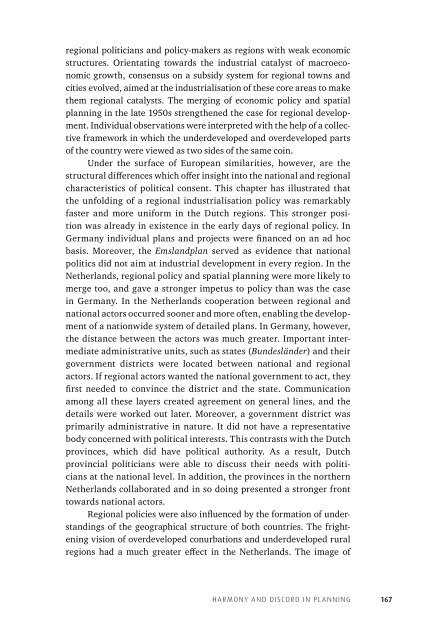Discord Consensus
7aze300jFJo
7aze300jFJo
Create successful ePaper yourself
Turn your PDF publications into a flip-book with our unique Google optimized e-Paper software.
egional politicians and policy-makers as regions with weak economic<br />
structures. Orientating towards the industrial catalyst of macroeconomic<br />
growth, consensus on a subsidy system for regional towns and<br />
cities evolved, aimed at the industrialisation of these core areas to make<br />
them regional catalysts. The merging of economic policy and spatial<br />
planning in the late 1950s strengthened the case for regional development.<br />
Individual observations were interpreted with the help of a collective<br />
framework in which the underdeveloped and overdeveloped parts<br />
of the country were viewed as two sides of the same coin.<br />
Under the surface of European similarities, however, are the<br />
structural differences which offer insight into the national and regional<br />
characteristics of political consent. This chapter has illustrated that<br />
the unfolding of a regional industrialisation policy was remarkably<br />
faster and more uniform in the Dutch regions. This stronger position<br />
was already in existence in the early days of regional policy. In<br />
Germany individual plans and projects were financed on an ad hoc<br />
basis. Moreover, the Emslandplan served as evidence that national<br />
politics did not aim at industrial development in every region. In the<br />
Netherlands, regional policy and spatial planning were more likely to<br />
merge too, and gave a stronger impetus to policy than was the case<br />
in Germany. In the Netherlands cooperation between regional and<br />
national actors occurred sooner and more often, enabling the development<br />
of a nationwide system of detailed plans. In Germany, however,<br />
the distance between the actors was much greater. Important intermediate<br />
administrative units, such as states (Bundesländer) and their<br />
government districts were located between national and regional<br />
actors. If regional actors wanted the national government to act, they<br />
first needed to convince the district and the state. Communication<br />
among all these layers created agreement on general lines, and the<br />
details were worked out later. Moreover, a government district was<br />
primarily administrative in nature. It did not have a representative<br />
body concerned with political interests. This contrasts with the Dutch<br />
provinces, which did have political authority. As a result, Dutch<br />
provincial politicians were able to discuss their needs with politicians<br />
at the national level. In addition, the provinces in the northern<br />
Netherlands collaborated and in so doing presented a stronger front<br />
towards national actors.<br />
Regional policies were also influenced by the formation of understandings<br />
of the geographical structure of both countries. The frightening<br />
vision of overdeveloped conurbations and underdeveloped rural<br />
regions had a much greater effect in the Netherlands. The image of<br />
Harmony and discord in planning 167


